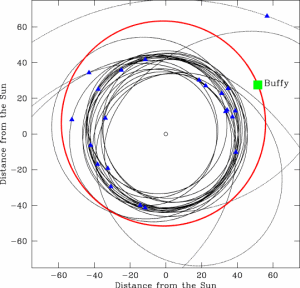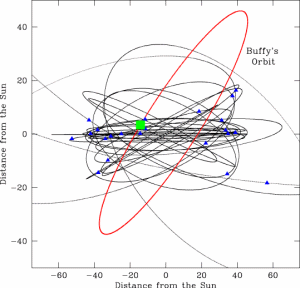16 December 2005
The Origin of the Solar System: Buffy Slays a Theory
By Rusty Rockets
 Scientists have spent a great many years trying to produce a consistent model of our Solar System's origin using one process, but the intricacies and magnitude of celestial interactions make this a supremely complex task. It's sometimes the case that as soon as researchers think they have nutted out the tangled orbits, trajectories and gravitational effects that shaped the Solar System, some planet or rock displays anomalous behavior that just doesn't quite fit the model.
Scientists have spent a great many years trying to produce a consistent model of our Solar System's origin using one process, but the intricacies and magnitude of celestial interactions make this a supremely complex task. It's sometimes the case that as soon as researchers think they have nutted out the tangled orbits, trajectories and gravitational effects that shaped the Solar System, some planet or rock displays anomalous behavior that just doesn't quite fit the model.
And it's happened again, with a new celestial object going by the fetching name of Buffy. Recent observations of Buffy and her wanderings through the Kuiper belt look set to throw much of our understanding of the Solar System's evolution out of the window.
Scientists have been studying the Kuiper belt in earnest since 1992, when they were finally able to confirm Dutch astronomer Jan Oort's 1950 hypothesis that comets came from there. The Kuiper belt is an enormous belt of icy rubble about 50,000 times farther from the Sun than the Earth. It's often referred to as the "final frontier" of the Solar System, a disk-shaped area of icy debris about 7.5 billion to 9.3 billion miles from the Sun. Astronomers believe that studying Kuiper belt objects (KBO) will dramatically help in revealing the origins of the Solar System.
Keen Kuiper aficionados in observatories around the world spend a significant amount of their time trawling through huge dollops of data in the hope of uncovering interesting and scientifically significant aspects of the Kuiper belt. Of recent interest, excitement and some consternation is a KBO, temporarily named "Buffy," that was first recorded by the Legacy Survey, a project that accumulates over 50 gigabytes of information per hour through the use of powerful telescopes and computers. By analyzing the various images and data returning to the observatory, computers select the most likely candidates of interest (something like looking for a hair in a bucket of spaghetti and meatballs) for human astronomers to investigate further.
 Astronomer Lynne Allen of the University of British Columbia made the initial discovery in December 2004. "It was quite bright compared to the usual Kuiper belt objects we find", said Dr. Allen. Since the first observations, Buffy's orbit has been verified and refined by the Kitt Peak National Observatories team of Joel Parker, JJ Kavelaars and Wes Fraser. Buffy has been reported to the Minor Planet Center, whose director, Brian Marsden, remarked: "To find the first known object with a nearly circular orbit beyond 50 AU [one astronomical unit - AU - is the distance between the Earth and the Sun] is indeed intriguing."
Astronomer Lynne Allen of the University of British Columbia made the initial discovery in December 2004. "It was quite bright compared to the usual Kuiper belt objects we find", said Dr. Allen. Since the first observations, Buffy's orbit has been verified and refined by the Kitt Peak National Observatories team of Joel Parker, JJ Kavelaars and Wes Fraser. Buffy has been reported to the Minor Planet Center, whose director, Brian Marsden, remarked: "To find the first known object with a nearly circular orbit beyond 50 AU [one astronomical unit - AU - is the distance between the Earth and the Sun] is indeed intriguing."
It's possible that this latest observation will prove more of a riddle than the as yet unanswered question of why Venus has a retrograde (backward) orbit. During routine operations, astronomers at the Canada-France Ecliptic Plane Survey tracked a small (by space standards) object that appeared to be approximately half the size of chilly Pluto that was located double the distance of Neptune from the sun. But Buffy just doesn't fit into current models of the Solar System; she's a loner, an outsider performing her own cosmic ballet. Buffy is about 58 AUs from the Sun, but astronomers have noticed that Buffy never comes within 50 AU of the Sun. This means that Buffy's orbit is all but circular, rather than elliptical, an unusual state of affairs for a quasi-planetary body. What is equally confusing to astronomers is that Buffy's orbit is tilted ("inclined," in space speak) at a significant 47 degrees relative to the rest of the Solar System. It is Buffy's bizarre and inexplicable orbit that will no doubt lead to insomnia among astronomers seeking answers.
 The reason why Buffy's orbit has caused such a tizzy among astronomers is that objects that venture outside of the Kuiper belt (50 AU) all demonstrate very high non-circular orbits, and until now scientists thought they had a model to explain why. The explanation given for the high eccentricity of Kuiper belt objects on the fringes of the Solar System is that they swoop in close enough (roughly within 38 AU of the Sun) to Neptune that the planet's gravitational pull slingshots them into their elliptical orbits. This group of objects is called the "Scattered Disk." There also exists another group of objects, called the "Extended Scattered Disk," that do not come within 50 AU of the Sun and therefore do not fall under Neptune's gravitational influence.
The reason why Buffy's orbit has caused such a tizzy among astronomers is that objects that venture outside of the Kuiper belt (50 AU) all demonstrate very high non-circular orbits, and until now scientists thought they had a model to explain why. The explanation given for the high eccentricity of Kuiper belt objects on the fringes of the Solar System is that they swoop in close enough (roughly within 38 AU of the Sun) to Neptune that the planet's gravitational pull slingshots them into their elliptical orbits. This group of objects is called the "Scattered Disk." There also exists another group of objects, called the "Extended Scattered Disk," that do not come within 50 AU of the Sun and therefore do not fall under Neptune's gravitational influence.
Astronomers have found a number of Extended Scattered Disk bodies other than Buffy that maintain an orbit beyond 50 AU of the Sun, such as 2000 CR105 and Sedna, but Sedna has a severe elliptical orbit, coming in as close as 76 AU before shooting back out as far as an inconceivable 900 AU. Buffy's nearly circular orbital corridor is, by comparison, miniscule in variation, ranging between 52 and 62 AU. There is a theory that may explain why Sedna and Buffy are not under Neptune's influence and why Buffy has a circular orbit. It is speculated that once the objects were scattered by Neptune a passing star could have pulled their closest approaches away from the Sun. So Buffy was pulled into a circular orbit and Sedna, being closer to the alleged star, pulled into an elliptical orbit away from Neptune's reach. Et voila! Problem solved! Not quite. To do so would require that we ignore Buffy's inexplicable 47 degree tilt, a factor that is not shared by other Extended Scattered Disk objects, such as Sedna.
Whatever perturbations led to Buffy's eccentric behavior requires an explanation that is, currently, not available to astronomers. While each new discovery adds to our knowledge of the Solar System, every Buffy that scientists stumble upon act as a reminder of how little we know.
More about Buffy from the Canada France Ecliptic Plane Survey
Cool animated simulation of Buffy's orbit
Orbital diagrams courtesy of Canada France Ecliptic Plane Survey
